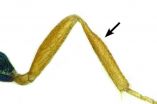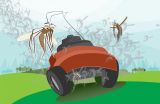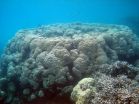Twisted wasps: Two new unique parasitoid wasp species sting the heart of Europe
2015-07-22
(Press-News.org) Much to his own surprise, Hannes Baur from the Natural History Museum Bern not only reports on whole two new parasitoid wasps at the heart of Europe, the Swiss Alps and Swiss Central Plateau. While the common discovery usually involves cryptic, or "camouflaging" within their groups species, his stand out. Baur's work is published in the open-access journal ZooKeys.
The insects he describes are visibly quite unique with their body structures. In the case of the Pteromalus briani wasp, its extraordinarily protruding hind legs differentiate it among the whole family. Meanwhile, the P. janstai wasp amazes with its unusually depressed middle part of the body.
The hind legs of the P. briani wasp species are described to be abruptly expanded unlike any other known species. The author points out that mere expansion has been observed in other representatives of the same family, but adds that "here they look quite different."
In addition, while in the rest of the cases the peculiarity is said to be due to courtship purposes because of its availability only with males, in the new species it is observed in both sexes. Therefore, Baur suggests that a scanning electron microscopy and histological sections of fresh material are the only way for the function of the character to be determined.
The second new species, the P. janstai wasp possesses an unusually flattened middle section of its body, which purpose is also yet to be figured out. The trait has been noticed before among species from unrelated genera, but its function could vary between the separate groups. A possible reason behind it is suggested to be the specificity of the parasite's host.
The author, however, is certain that the two new wasp species belong to the Pteromalus genus of parasitoids.
"The two records demonstrate that it is possible to discover entirely new species with extraordinary characters even in one of the most thoroughly explored taxonomically parts of the world," concludes the scientist.
INFORMATION:
Original source:
Baur H (2015) Pushing the limits - two new species of Pteromalus (Hymenoptera, Chalcidoidea, Pteromalidae) from Central Europe with remarkable morphology. ZooKeys 514: 43-72. doi: 10.3897/zookeys.514.9910
[Attachments] See images for this press release:


ELSE PRESS RELEASES FROM THIS DATE:
2015-07-22
CHAMPAIGN, Ill. -- A study of the West Nile virus risk associated with "dry" water-detention basins in Central Illinois took an unexpected turn when land managers started mowing the basins. The mowing of wetland plants in basins that failed to drain properly led to a boom in populations of Culex pipiens mosquitoes, which can carry and transmit the deadly virus, researchers report.
A paper describing their findings is in press in the journal Ecological Applications.
The team, led by University of Illinois postdoctoral researcher Andrew Mackay, found that mowing down cattails ...
2015-07-22
GeoSpace
Warmer air, less sea ice lead to mercury decline in Arctic Ocean
The amount of mercury in the Arctic Ocean is declining as the region rapidly warms and loses sea ice, according to a new study. A new study in Geophysical Research Letters suggests that fish, marine mammals, polar bears, whales and humans in the Arctic might potentially be consuming lower amounts of toxic methylmercury as the region warms.
Eos.org
Puzzles invite you to explore Earth with interactive imagery
The EarthQuiz challenge can take you to virtual field locations with just the click of ...
2015-07-22
The Mississippi River delta is a rich ecosystem of barrier islands, estuaries, and wetlands that's home to a diverse mix of wildlife -- as well as more than 2 million people. Over the past few decades, the shape of the delta has changed significantly, as ocean waves have carved away at the coastline, submerging and shrinking habitats.
To keep flooding at bay, engineers have erected dams and levees along the river. However, it's unclear how such protective measures will affect the shape of the river delta, and its communities, over time.
Now researchers from MIT and ...
2015-07-22
MELBOURNE, FLA. -- The coral reefs that have protected Pacific Islanders from storm waves for thousands of years could grow rapidly enough to keep up with escalating sea levels if ocean temperatures do not rise too quickly, according to a new study from Florida Institute of Technology.
The study, published Wednesday in the journal Royal Society Open Science, provides the first evidence that well-managed reefs will be able to keep up with sea-level rise through vertical growth. But that can happen only if carbon dioxide levels in the atmosphere stay below 670 parts-per ...
2015-07-22
PITTSBURGH, July 22, 2015 - Late- and post-menopausal women have significantly greater volumes of fat around their hearts - a risk factor for heart disease - than their pre-menopausal counterparts, a University of Pittsburgh Graduate School of Public Health study has shown for the first time.
The finding, published online and scheduled for the Sept. 1 issue of The Journal of Clinical Endocrinology & Metabolism, likely can be attributed to changing hormone levels and could guide potentially life-saving interventions. The work was funded by the National Institutes of Health ...
2015-07-22
Electronic cigarettes or "e-cigs" have been touted as a tool smokers can use to wean themselves off of traditional cigarettes, which many believe are more harmful than their "e" counterparts. But because e-cig liquid also contains nicotine and emits carcinogens, is that perception really true? One team now reports in the ACS journal Chemical Research in Toxicology that much of the nicotine in e-cigarettes is the addictive form of the compound.
Although e-cigs don't burn tobacco, they heat and vaporize a liquid that contains nicotine, flavorings and other substances. ...
2015-07-22
Stem cells hold great potential for addressing a variety of conditions from spinal cord injuries to cancer, but they can be difficult to control. Scientists are now reporting in the journal ACS Nano a new way to mimic the body's natural approach to programming these cells. Using this method, they successfully directed adult stem cells to turn specifically into muscle, which could potentially help treat patients with muscular dystrophy.
In the 1990s, scientists first isolated human embryonic stem cells, which can turn into any kind of cell in the body, and the promise ...
2015-07-22
A guideline--recommendations on diagnosing and treating a particular disorder--aims to present the best possible treatment for patients. However, when guidelines are compiled their authors often have conflicts of interest, for example as a result of funding or membership in specialist societies that are in close contact with industry. In a recent original article in Deutsches Ärzteblatt International (Dtsch Arztebl Int 2015; 112: 445-51), Gisela Schott et al. determine that most guideline authors do declare their conflicts of interest. However, this rarely has consequences ...
2015-07-22
Automakers are looking for ways to improve their fleets' average fuel efficiency, and scientists may have a new way to help them. In a report in the journal ACS Applied Materials & Interfaces, one team reports the development of a material that could convert engine heat that's otherwise wasted into electrical energy to help keep a car running -- and reduce the need for fuels. It could also have applications in aerospace, manufacturing and other sectors.
In 2012, the Obama administration announced fuel-efficiency standards that would require U.S. vehicles to average 54.5 ...
2015-07-22
Lithium-ion batteries remain the technology-of-choice for today's crop of electric cars, but challengers are revving up to try to upset the current order. An article in Chemical & Engineering News (C&EN), the weekly newsmagazine of the American Chemical Society, takes a look at two of the top contenders vying to erode lithium-ion's dominance.
Alex Scott, a senior editor at C&EN, reports on two developments from companies in England that seem poised to compete in the electric car battery market within the next two to four years. One is a sodium-ion version, produced by ...
LAST 30 PRESS RELEASES:
[Press-News.org] Twisted wasps: Two new unique parasitoid wasp species sting the heart of Europe



